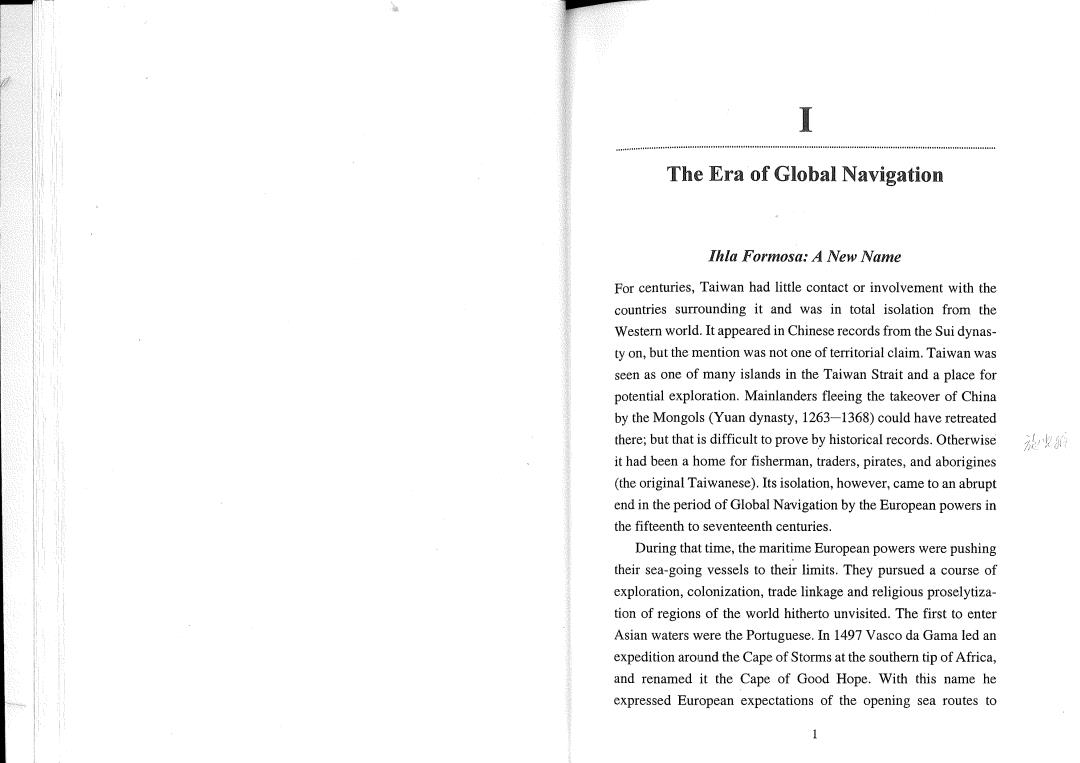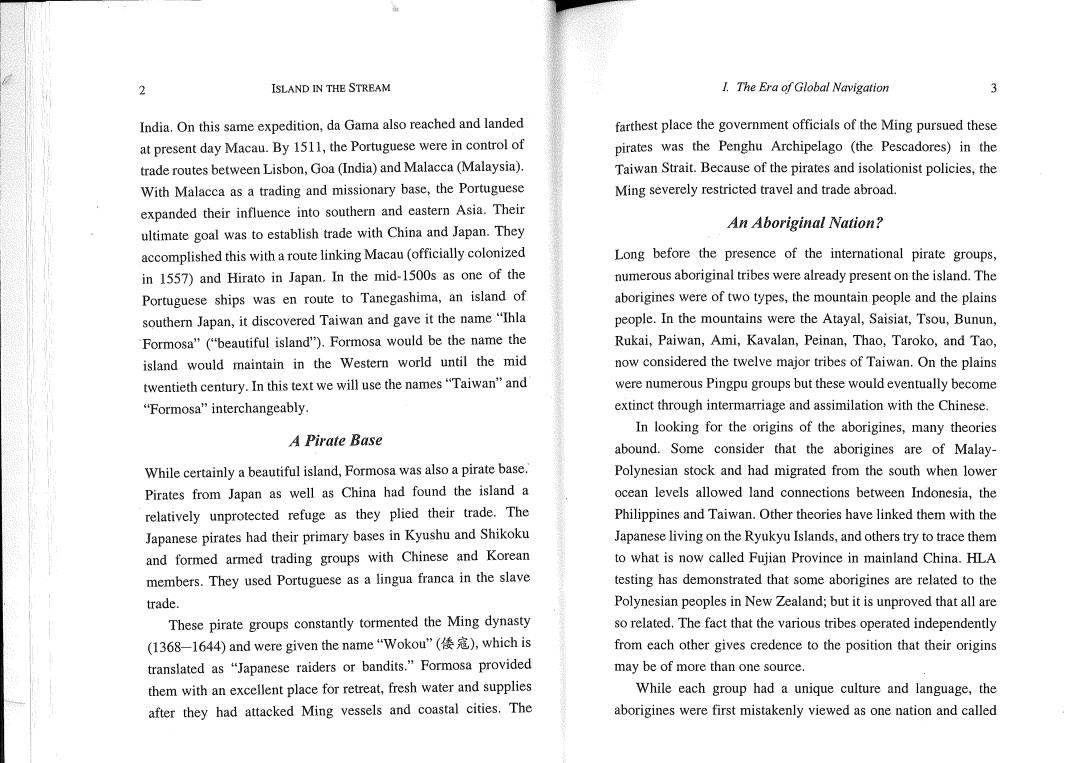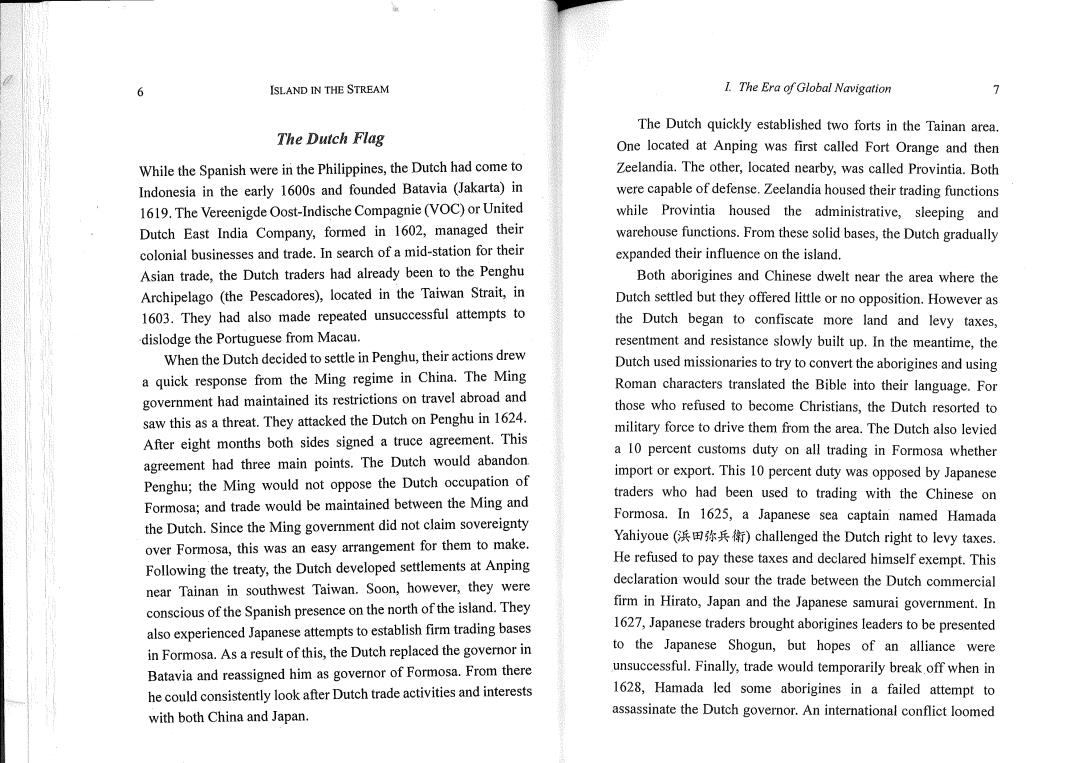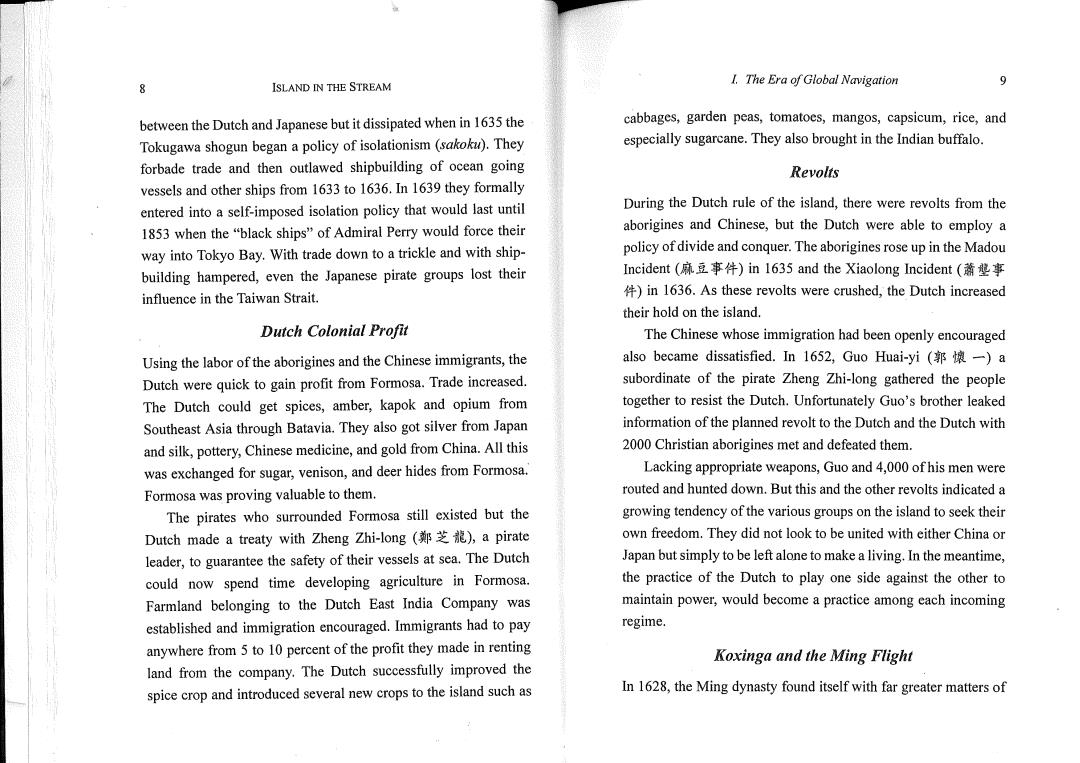
The Era of Global Navigation Thla Formosa:A New Name For centuries,Taiwan had little contact or involvement with the countries surrounding it and was in total isolation from the Western world.It appeared in Chinese records from the Sui dynas- ty on,but the mention was not one of territorial claim.Taiwan was seen as one of many islands in the Taiwan Strait and a place for potential exploration.Mainlanders fleeing the takeover of China by the Mongols (Yuan dynasty,1263-1368)could have retreated there;but that is difficult to prove by historical records.Otherwise 油曳解 it had been a home for fisherman,traders,pirates,and aborigines (the original Taiwanese).Its isolation,however,came to an abrupt end in the period of Global Navigation by the European powers in the fifteenth to seventeenth centuries. During that time,the maritime European powers were pushing their sea-going vessels to their limits.They pursued a course of exploration,colonization,trade linkage and religious proselytiza- tion of regions of the world hitherto unvisited.The first to enter Asian waters were the Portuguese.In 1497 Vasco da Gama led an expedition around the Cape of Storms at the southern tip of Africa, and renamed it the Cape of Good Hope.With this name he expressed European expectations of the opening sea routes to

2 ISLAND IN THE STREAM I.The Era of Global Navigation 3 India.On this same expedition,da Gama also reached and landed farthest place the government officials of the Ming pursued these at present day Macau.By 1511,the Portuguese were in control of pirates was the Penghu Archipelago (the Pescadores)in the trade routes between Lisbon,Goa (India)and Malacca(Malaysia). Taiwan Strait.Because of the pirates and isolationist policies,the With Malacca as a trading and missionary base,the Portuguese Ming severely restricted travel and trade abroad. expanded their influence into southern and eastern Asia.Their ultimate goal was to establish trade with China and Japan.They An Aboriginal Nation? accomplished this with a route linking Macau (officially colonized Long before the presence of the international pirate groups, in 1557)and Hirato in Japan.In the mid-1500s as one of the numerous aboriginal tribes were already present on the island.The Portuguese ships was en route to Tanegashima,an island of aborigines were of two types,the mountain people and the plains southern Japan,it discovered Taiwan and gave it the name "Thla people.In the mountains were the Atayal,Saisiat,Tsou,Bunun, Formosa"("beautiful island").Formosa would be the name the Rukai,Paiwan,Ami,Kavalan,Peinan,Thao,Taroko,and Tao, island would maintain in the Western world until the mid now considered the twelve major tribes of Taiwan.On the plains twentieth century.In this text we will use the names"Taiwan"and were numerous Pingpu groups but these would eventually become "Formosa"interchangeably. extinct through intermarriage and assimilation with the Chinese. In looking for the origins of the aborigines,many theories A Pirate Base abound.Some consider that the aborigines are of Malay- While certainly a beautiful island,Formosa was also a pirate base. Polynesian stock and had migrated from the south when lower Pirates from Japan as well as China had found the island a ocean levels allowed land connections between Indonesia,the relatively unprotected refuge as they plied their trade.The Philippines and Taiwan.Other theories have linked them with the Japanese pirates had their primary bases in Kyushu and Shikoku Japanese living on the Ryukyu Islands,and others try to trace them and formed armed trading groups with Chinese and Korean to what is now called Fujian Province in mainland China.HLA members.They used Portuguese as a lingua franca in the slave testing has demonstrated that some aborigines are related to the trade. Polynesian peoples in New Zealand;but it is unproved that all are These pirate groups constantly tormented the Ming dynasty so related.The fact that the various tribes operated independently (1368-1644)and were given the name“Wokou'”(偻寇,which is from each other gives credence to the position that their origins translated as "Japanese raiders or bandits."Formosa provided may be of more than one source. them with an excellent place for retreat,fresh water and supplies While each group had a unique culture and language,the after they had attacked Ming vessels and coastal cities.The aborigines were first mistakenly viewed as one nation and called

4 ISLAND IN THE STREAM 1.The Era of Global Navigation 5 the "Takasago"("high mountain people")by the Japanese.It was an appropriate name since the central mountain range of Taiwan The Spanish Flag has 200 peaks taller than 3,000 meters. Ferdinand Magellan,a Portuguese explorer in the service of Spain, Inl593,the Japanese king Toyotomi Hideyoshi(豐臣秀吉) left in 1519 in a bold and adventurous attempt to sail around the dispatched Harada Magoshitiro(原田孫七郎)as an ambassador to world.He reached and died in the Philippines in 1521;but one of this"High Mountain Nation."Hideyoshi sought to invade China his five ships would complete this unprecedented adventure by and had two routes available;one through Korea and the other 1523.Encouraged by this voyage,the Spanish returned and by through Formosa.Finding that no one tribe in Formosa could 1565 conquered the Philippines.Spanish interest in Formosa soon representatively speak for all,he chose the route of Korea.It was developed;they saw it as a midway point between their a bad choice and got Japan involved in an eventual quagmire on Philippines settlements and Japan.By occupying Taiwan,they that peninsula.When he died in 1598,his campaign was could provide security for the Bashi Channel,share or snatch the abandoned.If he had gone through Formosa,perhaps Hideyoshi Formosan trade from the Dutch and more easily dominate trade would have fared no better.Regardless,this was the first routes to Japan.In 1626,despite setbacks in Japan,Spanish fleets experience where Formosa was viewed or treated as an from Manila landed on the northeastern coast of Formosa and independent country by an outsider. named the place Santiago.They also entered Keelung and The Name Taiwan established Fort San Salvador.Two years later they occupied Tamsui on the northwestern coast and established Fort Santo The origins of the name of Taiwan are disputed.Some interpret it Domingo.Spanish influence was limited to the northern portion of as a corruption of the name of the locale (Taoyuan)where the the island.But after seventeen years,they withdrew.Their reasons earliest settlements were made.Others see it as the aborigines' were many.In addition to being attacked by the Dutch and by the name for aliens.When Chinese,Japanese or other aliens came to aborigines,many of their soldiers also died of illness.But their Formosa,the aborigines people would talk of them as "Taian,or main reason for withdrawal was that the samurai government in Taiyan"both words which meant"aliens."As often happens in the Japan continued to refuse the Spanish the right to trade and misunderstanding of language,Dutch traders who later heard proselytize.As the Japanese continued to persecute Christians these words,associated them with the island and gave Formosa the there was little hope that this position would be reversed. name Taiwan from these utterances.That same name also appears Defending Formosa lost its value,and the Spanish returned to the in the Ming court's agreement to the occupation of Taiwan by the Philippines. Dutch

ISLAND IN THE STREAM 1.The Era of Global Navigation The Dutch quickly established two forts in the Tainan area. The Dutch Flag One located at Anping was first called Fort Orange and then While the Spanish were in the Philippines,the Dutch had come to Zeelandia.The other,located nearby,was called Provintia.Both Indonesia in the early 1600s and founded Batavia (Jakarta)in were capable of defense.Zeelandia housed their trading functions 1619.The Vereenigde Oost-Indische Compagnie(VOC)or United while Provintia housed the administrative,sleeping and Dutch East India Company,formed in 1602,managed their warehouse functions.From these solid bases,the Dutch gradually colonial businesses and trade.In search of a mid-station for their expanded their influence on the island. Asian trade,the Dutch traders had already been to the Penghu Both aborigines and Chinese dwelt near the area where the Archipelago (the Pescadores),located in the Taiwan Strait,in Dutch settled but they offered little or no opposition.However as 1603.They had also made repeated unsuccessful attempts to the Dutch began to confiscate more land and levy taxes, dislodge the Portuguese from Macau. resentment and resistance slowly built up.In the meantime,the When the Dutch decided to settle in Penghu,their actions drew Dutch used missionaries to try to convert the aborigines and using a quick response from the Ming regime in China.The Ming Roman characters translated the Bible into their language.For government had maintained its restrictions on travel abroad and those who refused to become Christians,the Dutch resorted to saw this as a threat.They attacked the Dutch on Penghu in 1624. military force to drive them from the area.The Dutch also levied After eight months both sides signed a truce agreement.This a 10 percent customs duty on all trading in Formosa whether agreement had three main points.The Dutch would abandon. Penghu;the Ming would not oppose the Dutch occupation of import or export.This 10 percent duty was opposed by Japanese Formosa;and trade would be maintained between the Ming and traders who had been used to trading with the Chinese on the Dutch.Since the Ming government did not claim sovereignty Formosa.In 1625,a Japanese sea captain named Hamada over Formosa,this was an easy arrangement for them to make. Yahiyoue(浜田弥兵術)challenged the Dutch right to levy taxes. Following the treaty,the Dutch developed settlements at Anping He refused to pay these taxes and declared himself exempt.This near Tainan in southwest Taiwan.Soon,however,they were declaration would sour the trade between the Dutch commercial conscious of the Spanish presence on the north of the island.They firm in Hirato,Japan and the Japanese samurai government.In also experienced Japanese attempts to establish firm trading bases 1627,Japanese traders brought aborigines leaders to be presented in Formosa.As a result of this,the Dutch replaced the governor in to the Japanese Shogun,but hopes of an alliance were Batavia and reassigned him as governor of Formosa.From there unsuccessful.Finally,trade would temporarily break off when in he could consistently look after Dutch trade activities and interests 1628,Hamada led some aborigines in a failed attempt to with both China and Japan. assassinate the Dutch governor.An international conflict loomed

I.The Era of Global Navigation 9 8 ISLAND IN THE STREAM between the Dutch and Japanese but it dissipated when in 1635 the cabbages,garden peas,tomatoes,mangos,capsicum,rice,and Tokugawa shogun began a policy of isolationism (sakoku).They especially sugarcane.They also brought in the Indian buffalo. forbade trade and then outlawed shipbuilding of ocean going Revolts vessels and other ships from 1633 to 1636.In 1639 they formally entered into a self-imposed isolation policy that would last until During the Dutch rule of the island,there were revolts from the 1853 when the "black ships"of Admiral Perry would force their aborigines and Chinese,but the Dutch were able to employ a way into Tokyo Bay.With trade down to a trickle and with ship- policy of divide and conquer.The aborigines rose up in the Madou building hampered,even the Japanese pirate groups lost their Incident(麻豆事件)inI635 and the Xiaolong Incident(蕭壟事 influence in the Taiwan Strait. )in 1636.As these revolts were crushed,the Dutch increased their hold on the island. Dutch Colonial Profit The Chinese whose immigration had been openly encouraged Using the labor of the aborigines and the Chinese immigrants,the also became dissatisfied..n1652,Guo Huai-yi(郭懷一)a Dutch were quick to gain profit from Formosa.Trade increased. subordinate of the pirate Zheng Zhi-long gathered the people The Dutch could get spices,amber,kapok and opium from together to resist the Dutch.Unfortunately Guo's brother leaked Southeast Asia through Batavia.They also got silver from Japan information of the planned revolt to the Dutch and the Dutch with and silk,pottery,Chinese medicine,and gold from China.All this 2000 Christian aborigines met and defeated them. was exchanged for sugar,venison,and deer hides from Formosa. Lacking appropriate weapons,Guo and 4,000 ofhis men were Formosa was proving valuable to them. routed and hunted down.But this and the other revolts indicated a The pirates who surrounded Formosa still existed but the growing tendency of the various groups on the island to seek their Dutch made a treaty with Zheng Zhi-long(鄭芝龍),a pirate own freedom.They did not look to be united with either China or leader,to guarantee the safety of their vessels at sea.The Dutch Japan but simply to be left alone to make a living.In the meantime, could now spend time developing agriculture in Formosa. the practice of the Dutch to play one side against the other to Farmland belonging to the Dutch East India Company was maintain power,would become a practice among each incoming established and immigration encouraged.Immigrants had to pay regime. anywhere from 5 to 10 percent of the profit they made in renting Koxinga and the Ming Flight land from the company.The Dutch successfully improved the spice crop and introduced several new crops to the island such as In 1628,the Ming dynasty found itself with far greater matters of